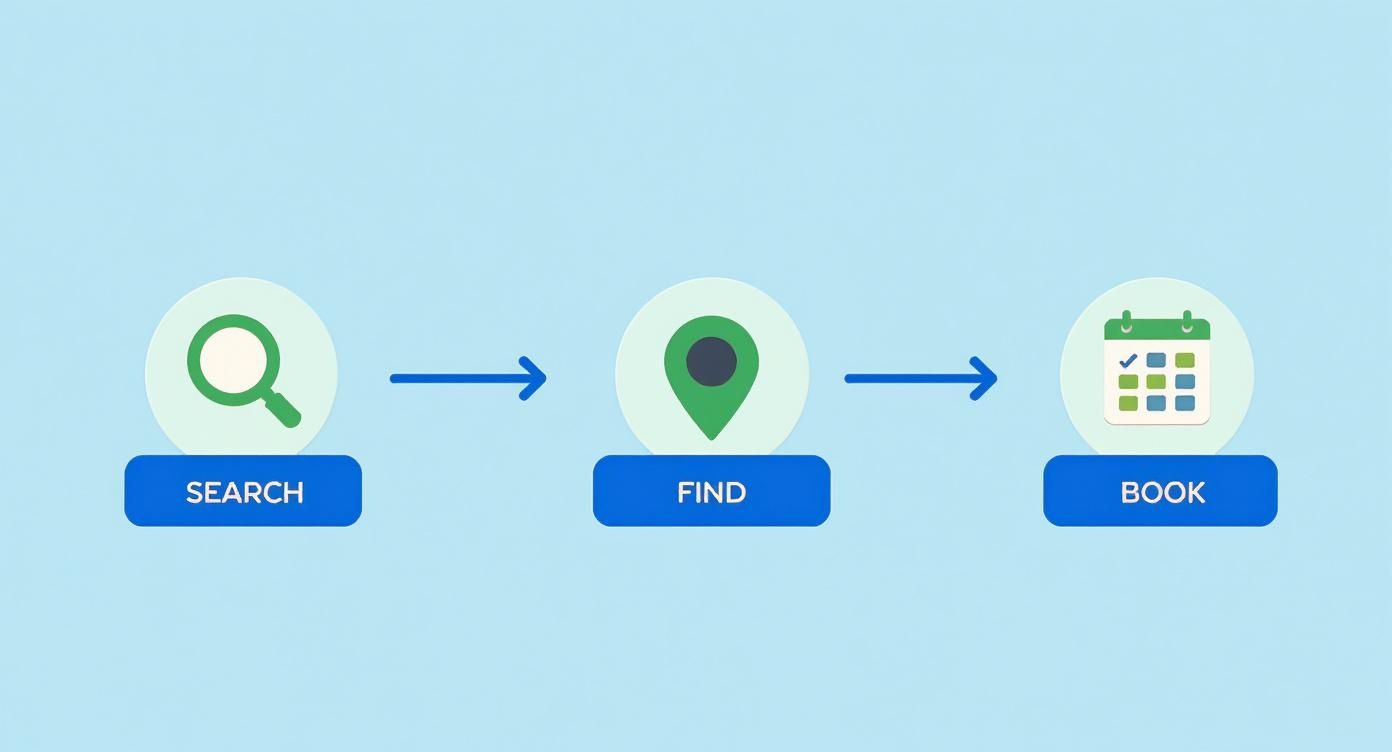When you need a new service, you probably pull out your phone and do a quick Google search. Your potential patients do the exact same thing. SEO for medical practice is how you make sure your website shows up when they search.
It's about making your practice visible, credible, and helpful the moment someone in your community needs care.
Why SEO Is Your Practice's New Front Door
Years ago, patients found doctors through referrals or insurance directories. Today, their journey almost always starts online. They search for symptoms, look for treatments, or type "cardiologist near me" into Google.
This means your website isn't just a brochure. It’s the main way you attract new patients. Before we dive in, it helps to understand the basics of What Is Search Engine Optimization for Business and why it's vital for local practices.
The data supports this shift. By 2025, an estimated 74% of patients will look up a doctor online before booking an appointment. This stat shows a direct link between a strong online presence and a growing patient list.
In Short: Your website is the new front door to your practice. If patients can't find you online, they won’t walk through your physical one.
The Modern Patient Journey
The path from a health concern to a booked appointment is predictable. It usually starts with a search.
This infographic shows the typical steps a patient takes when looking for a new doctor.

Showing up in search results is the crucial first step. If you're not there, you are invisible to most people looking for your services.
Local Search Is a Huge Opportunity
For most medical practices, the best patients are the ones who live nearby. This is why local SEO is so powerful. When someone searches for a doctor, Google often shows a map with local listings first. Getting your practice on that map is a game-changer.
Focusing on local search connects you with people in your area who are actively looking to book an appointment now. These are high-intent potential patients ready to take action.
Finding the Keywords Your Patients Actually Use
Effective SEO requires understanding your patients. It's not about ranking for "doctor." It's about knowing the exact phrases people use when they need to schedule an appointment.
You need to learn their digital language.
The goal is to find keywords like "weekend pediatric appointments in Dallas" or "best non-surgical knee pain treatment." These searches are a direct line to a patient who needs your specific services.

Cracking the Code of Patient Intent
Patient intent is the most important concept in keyword research. You must understand the difference between someone researching a symptom and someone trying to find a specialist.
Patient searches fall into three main categories:
- High-Intent (Ready to Book): These people want a provider now. Their searches are specific and often include a location. Examples include "cardiologist near me" or "schedule eye exam."
- Medium-Intent (Considering Options): This person might have a diagnosis and is figuring out the next steps. They search for "lumbar discectomy recovery" or "invisalign vs braces for adults."
- Low-Intent (Information Gathering): These users are at the beginning of their journey. They use broad, symptom-based questions like "why does my back hurt."
In Short: Your primary focus should be on high-intent and medium-intent searches. These are the queries that will fill your appointment calendar.
How to Find Patient Keywords
You don't need expensive software to start. Some of the best tools are free.
- Google's "People Also Ask" (PAA): Just type a condition or treatment you offer into Google. The PAA section shows real questions people are asking. Each question is a potential keyword or blog topic.
- Google Keyword Planner: This free tool is a goldmine for SEO data. Our guide on how to use Google's Keyword Planner can help you get started.
Building Your Core Keyword List
Let's put this into practice. Open a spreadsheet and brainstorm keywords for these categories:
- Your Services & Treatments: Be specific. List "ACL reconstruction surgery" and "carpal tunnel release," not just "orthopedics."
- Conditions You Treat: Use patient language. They search for "sinus infection treatment," not "otolaryngology services."
- Location-Based Terms: Combine your services with your city and neighborhood. Think "pediatrician in South Austin."
Use the tools mentioned above to expand your list and confirm people are searching for these terms. This process is the foundation of a smart content strategy.
Winning Local Search in Your Neighborhood
For most practices, winning at SEO for medical practice means dominating your local area. Local search isn't just part of the strategy; it is the strategy.
For some practices, a huge 70% of organic search traffic comes from local map listings, not even from clicks to their website.
When a patient searches "orthopedist near me," they need a phone number and address fast. Your goal is to be in the top three results Google shows in the "local pack" map box.
Your Google Business Profile is Your Digital Front Desk
Your Google Business Profile (GBP) is your most valuable online real estate. It's the info box that appears on Google Maps and in local search. Getting this right is non-negotiable.
You have to treat it like a mini-website and fill out every section.
- Pick the Right Categories: Be specific. Choose "Family Practice Physician" or "Cardiologist" as your primary category. Add secondary ones for other services.
- Detail Your Services: List every procedure and treatment you provide. This helps Google match you to specific searches like "Botox for migraines."
- Upload Photos: Add high-quality, recent photos of your office exterior, waiting room, and staff. This builds trust.
- Use Google Posts: Regularly share updates using the "Posts" feature. Announce new equipment or share a health tip. It shows you're active.
The Role of Patient Reviews
Online reviews are the new word-of-mouth. A steady stream of recent, positive reviews is a powerful local ranking factor.
Key Insight: Many new patients choose between two similar doctors based on the number and quality of recent online reviews.
You need a simple process for asking patients for feedback. An automated email or text after their appointment works well. Include a direct link to your Google review page to make it easy.
What Is NAP and Why Is It Important?
NAP stands for Name, Address, and Phone number. This information is the foundation of local SEO. Google uses it to verify your practice is a legitimate business.
Inconsistencies are a major red flag. Your NAP must be 100% identical everywhere it appears online, including:
- Google Business Profile
- Apple Maps
- Yelp
- WebMD
- Vitals.com
- Healthgrades
Ensuring consistency is a foundational task. You can learn more in our guide on local SEO services for small businesses.
Frequently Asked Questions About Local SEO for Doctors
Here are a few common questions practice managers ask about local search.
How do I handle multiple office locations?
Create a separate Google Business Profile for each physical address. It's also a good idea to create individual landing pages on your website for each office.
Should our doctors have their own profiles?
Yes. In a multi-provider practice, each physician should have their own GBP listing linked to the main practice. Patients often search for doctors by name.
What's the best way to respond to patient reviews?
Respond to all of them. For positive feedback, a simple "thank you" is enough. For negative reviews, stay professional and empathetic. Acknowledge their concerns without violating HIPAA and offer to take the conversation offline.
Creating Content That Builds Patient Trust
Your website's content does more than just rank on Google. It's your first chance to build trust with a potential patient. When people are worried about their health, they want reassurance from a credible source.

Google filters content through a concept called E-E-A-T: Experience, Expertise, Authoritativeness, and Trustworthiness. For medical websites, this is the gold standard. You must prove you are a legitimate, knowledgeable, and trustworthy provider.
What is E-E-A-T in practice?
- Experience: Show your work through detailed procedure pages or case studies (always protecting patient privacy).
- Expertise: Showcase your physicians' credentials, specializations, and publications.
- Authoritativeness: Build your reputation through patient reviews, mentions in local news, and links from other respected health websites.
- Trustworthiness: Make your contact info easy to find, have a clear privacy policy, and secure your site with HTTPS.
In Short: E-E-A-T is Google's way of asking, "Can I confidently send someone with a health concern to this website?" Your content should make the answer "yes."
Content That Connects with Patients
Generic blog posts won't work. Your content must be specific, helpful, and tied to your services. Think of your website as a digital extension of your patient care.
Here are some effective content types for medical practices:
| Content Type | Primary Goal | Example Topic |
|---|---|---|
| Detailed Service Pages | Educate patients on procedures and manage expectations. | "What to Expect During and After Arthroscopic Knee Surgery" |
| Condition-Specific Hubs | Become a go-to resource for a specific health issue. | "A Complete Guide to Managing Type 2 Diabetes" |
| Physician Bios | Humanize your doctors and showcase their expertise. | Include a short video of the doctor explaining their specialty. |
| Patient Testimonials | Provide social proof and build confidence. | "How Dr. Evans Helped Me Get Back to Running" |
| FAQ Pages | Answer common questions about insurance, appointments, and procedures. | "Does my insurance cover telehealth?" |
This type of content targets keywords and directly addresses patient concerns, building immediate confidence.
Answering Real Patient Questions
Patients are using voice search and asking full, conversational questions. To learn more about this trend, you can read about the current state of SEO for doctors.
Think about the questions your front desk staff hears every day:
- "How long is the recovery for…?"
- "Is this procedure painful?"
- "What are the alternatives to…?"
Each of these is a great opportunity for a blog post or video. By answering these questions on your site, you provide value and align your content with how people search for help.
Fixing Technical Issues That Hurt Your Ranking
Your website can look great, but if Google can't crawl it properly, it's invisible. Technical SEO is the "under the hood" work that builds a solid foundation for your marketing efforts.
The top five organic search results get a huge 81% of all clicks. Google also fields over 1 billion health-related questions every day. If technical glitches hold your site back, you're missing out on many potential patients. You can find more data on how patients use search engines on SERMO.
Is Your Website Mobile-Friendly and Fast?
More than half of all web traffic comes from mobile devices. For a patient looking for a doctor on their phone, a slow website is a dealbreaker.
Google prioritizes mobile-friendly websites in its rankings.
- Is it responsive? Your website should look great on any screen.
- Are buttons easy to tap? Can someone easily tap "Call Now" with their thumb?
- How fast does it load? A site that takes more than three seconds to load loses visitors.
Use Google's free PageSpeed Insights tool to check your site's performance.
The Power of Schema Markup for Doctors
Schema markup is code that acts as a translator for search engines. It gives Google clear information about your practice.
Schema tells Google things like:
- "This is a medical clinic."
- "This is the clinic's address."
- "This person is a physician."
- "These are patient reviews with an average rating of 4.9 stars."
The Bottom Line: Schema helps Google feature eye-catching details like star ratings in the search results, making your listing more likely to be clicked.
Frequently Asked Questions About Technical SEO
Here are a few common questions about the technical side of SEO for a medical practice.
What is HTTPS and why does it matter?
HTTPS is the secure version of HTTP. It encrypts the connection between a patient's browser and your website, protecting their privacy. A site without the padlock icon looks unprofessional and unsafe.
How important is a simple site structure?
Very important. Your website's navigation should be intuitive. A new patient should be able to find what they need in one or two clicks. A confusing layout frustrates users and search engines.
Do I really need a sitemap?
Yes. A sitemap is a file that lists all the pages on your website. It's like a roadmap for search engines, helping them discover and index your content more efficiently.
Got Questions About SEO for Your Practice? We’ve Got Answers.
Jumping into SEO can feel overwhelming. Doctors and practice managers often ask similar questions about time, cost, and what really matters. Let's tackle them.
How long until I see results from SEO?
SEO is a long-term strategy. You might see positive signs like better rankings within 3 to 6 months. But turning that traffic into a steady stream of new patients typically takes 6 to 12 months. The competitiveness of your local market and your consistency will affect this timeline.
Should I do this myself or hire someone?
You can handle some basics yourself. Most practices can manage their Google Business Profile, ask for patient reviews, and write basic blog content answering common questions.
For deeper work like technical SEO and building backlinks, a specialized healthcare SEO agency is a good investment. They have the tools and time a busy practice lacks.
My Two Cents: A great agency understands the healthcare world, including compliance rules like HIPAA and the importance of patient trust.
What is the most important part of SEO for doctors?
If you can only focus on one thing, make it Local SEO. Your patients are looking for a provider in their neighborhood.
Your local strategy comes down to three key things:
- A flawless Google Business Profile.
- A constant flow of new, positive patient reviews.
- Perfectly consistent Name, Address, and Phone number (NAP) online.
Nailing these fundamentals will give you the biggest and fastest return on your effort.
Ready to attract more patients? At Clicks Geek, we create data-driven SEO strategies that fill appointment books for medical practices. We handle the complexities of digital marketing so you can focus on patient care. Find out how we can help your practice grow.
Is Your Business Ranking in Google Maps?
Turn Google Maps into a Lead Engine w/ Clicks Geek’s AI-powered local SEO. 3,000+ clients served. Our proprietary, fully done-for-you Maps SEO system handles everything—keyword targeting, local optimization, content, reviews, and ranking strategy—automatically.






